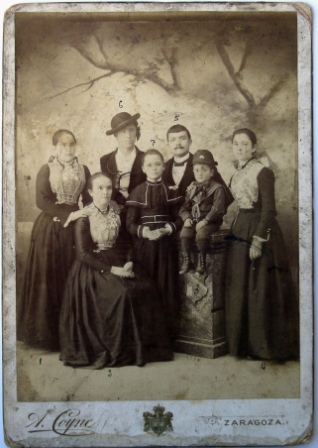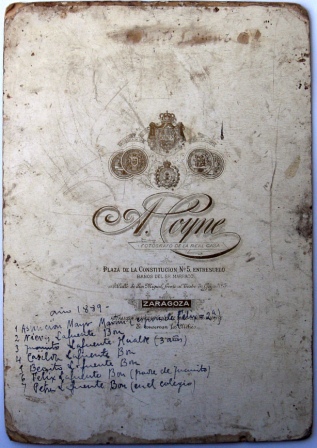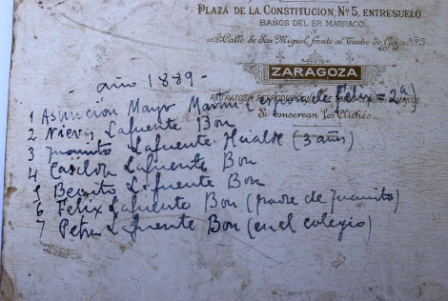The piece of the month of July 2016
NEWS ABOUT A PHOTOGRAPH OF RONCALESES OF 1889
José Ignacio Riezu Boj
research center in Nutrition
University of Navarra
In many houses in the Roncal Valley there are photographs from the late 19th and early 20th centuries that show their inhabitants dressed in traditional Roncal costume. Many of these photographs correspond to the reportage that was carried out on the occasion of the wedding. Photography at that time was a luxury item and although some families could afford it, for most of them, this was the only time they would get in front of the camera during their whole life.
The main snapshot in the report was the photograph of the couple, although depending on the possibilities of the family, a small report with images of the newlyweds surrounded by their relatives could be included. For this occasion, the Roncaleses wore the gala costume. The costume worn by the inhabitants of the valley for attend to the Sunday celebrations or for the great festivities of the year. A costume that was part of the trousseau and that had to serve for their whole life.
This is the case of the photograph that concerns us. We are in front of the family of Félix Lafuente Bon, one of the wealthy families of the town of Roncal. It is the year 1889 and the piece that we study belongs to the report of the second marriage of Félix (marked with the issue 6) with Asunción Mayo (marked with the issue 1) of Uztarroz. The previous year, 1888, had been an ill-fated year for "Casa Molinero", two members of the family had died: Felix's first wife, Justina Hualde at the age of 28, leaving a young son, and the head of the family, Fructuoso Lafuente, Felix's father, at the age of 59.
Our photograph shows the family of the bride and groom, as indicated by the notes on the back. In addition to the aforementioned Felix and his new wife, Felix's siblings appear: Nieves (2), Casilda (4), Benito (5) and Petra (7) and the son of his first marriage, Juanito Lafuente Hualde, 2 years old. Nieves, 29 years old, was married to Pedro José Orduna Martín and lived in Roncal. Nieves would be the future mother of the famous sculptor Fructuoso Orduna, born in Roncal in 1893. Casilda, 17 years old, was single and lived in her native house in Roncal, where she took care of her brother and his son. Benito, 20 years old, lived in Zaragoza and his younger sister, Petra, 12 years old, who appears in the photograph wearing the uniform of the high school in Zaragoza where she studied, had gone to live with him.

Photograph of the link by Félix Lafuente with Asunción Mayo
(Private collection)

Rerverso of photography
(Private collection)

Handwritten notes on the back of the photograph with the identification of the characters.
(Private collection)
The family had chosen Anselmo Coyne, one of the most famous photographers in the city of Zaragoza, to take their portrait. Coyne had begun his work as a photographer at the place del Castillo in Pamplona, his hometown, but by 1878, he moved to Zaragoza where he came to hold one of the most prestigious programs of study in photography in the city with the title of photographer of SS. MM. and the honors of using the royal coat of arms on his cards.
This photograph, in the elegant Cabinet format (16 x cm), stands out for the seriousness and haughtiness shown by the characters, characteristics that are far from the current photographs in which the important thing is to show an exultant smile. They also highlight the sobriety and harmony of the whole. A simple backdrop with tree branches and a rectangular pedestal, where they have placed the child, are the only decorations of the composition. The arrangement of the people, one seated, most of them standing and the child sitting on the pedestal, manages to place all the gazes of our characters on the same horizontal line, in the upper third of the photograph. But what stands out in the scene is the packaging and elegance of the women's costumes. All these characteristics give a great harmony to the composition.
The clothing shown by the four characters in the photograph was exclusive to the inhabitants of the Roncal Valley. Its use was very legislated, both in the ordinances of the valley and in different orders of the seven villages of the valley. They expressly prohibited the use of these garments by people from outside the valley as well as by inhabitants of the valley who did not have Roncal ancestry such as "foreigners" or "agotes". The clothing worn by the women in the photograph consists of a woolen doublet, with white lace at the ends of the long, narrow sleeves. The doublet, very tight, is tied at the front with a cord that hangs on one side. The doublet partly covers a sleeveless black wool vest or vest, which is worn underneath. Both garments have large bands of embroidery or gallons on the neckline, giving rise to a characteristic front decoration, which stands out for its gold and silver metallic threads, on the black of the wool. Underneath these garments, the Roncalesa wears a blouse with beautiful honeycomb embroidery of which only the collar is visible. The skirts they wear are large black pleated skirts. The jewels they wear around their necks are a large four-piece golden jeweled bow and a pearl necklace with a multitude of strands. The two jewels, which are tied with a black ribbon, can be fill in with earrings, although in this photograph they do not appear to be wearing them. On the head they wear two long braids adorned at the beginning and at the end with large colored ribbons. Felix wears a black vest over a white jacket or elastic with dark piping and on his head a scarf or headdress knotted on one side and over it a tilted sastago hat.
In the photograph you can see how the members of the family who lived in Roncal wear the traditional clothing of the valley. However, those who live in Zaragoza and the child (Benito, Petra and Juanito) wear the fashion of the city. The photograph shows the profound changes that the valley and the whole Pyrenees underwent in the 20th century. Changes that in our snapshot are of clothing, but in reality were much deeper, changes imposed by modernity and cultural globalization.
This photograph is a reminder of a time, which has now disappeared, when clothing was a badge of identity, dignity and pride, but also of discrimination. A time when being from Roncal was lived with optimism and confidence, convinced that the collective nobility granted by the kings of Navarre, as well as its peculiar institutions, was a distinction that had to be practiced.
SOURCES AND bibliography
-HUALDE, F., Indumentaria Roncalesa, Lamiñarra, 2013.
-IDOATE, F., La Comunidad del Valle de Roncal, Diputación Foral de Navarra, 1977.
-MIGUÉLIZ VALCARLOS, I., "Fotógrafos navarros en la colección fotográfica del Marques de la Real Defensa", Cuadernos de la Chair de Patrimonio y Arte de Navarra (Fotografía en Navarra: fondos, colecciones y fotógrafos), nº 6 , 2011.
-RIEZU BOJ, J. I., El traje tradicional roncalés en documentos notariales del valle de Roncal, Cuadernos de Etnología y Etnografía de Navarra, nº 87, 2012.
-ROMERO, A., La Fotografía en Aragón, Zaragoza, Ibercaja, 1999.
